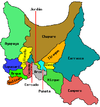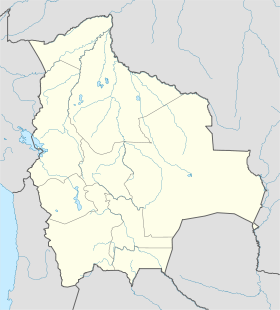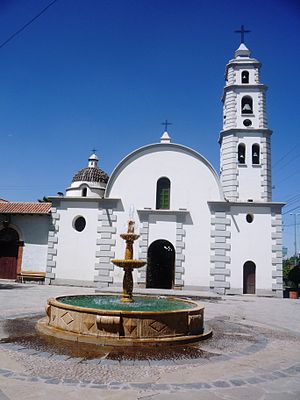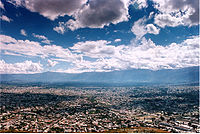- Cochabamba
-
Coordinates: 17°23′S 66°10′W / 17.383°S 66.167°W
Cochabamba 
Flag
SealNickname(s): "City of Eternal Spring"
"The Garden City"
"La Llajta"Location in Bolivia Coordinates: 17°23′S 66°10′W / 17.383°S 66.167°W Country  Bolivia
BoliviaDepartment Cochabamba Province Cercado Province Municipality Cochabamba Municipality Area – City 348 km2 (134.4 sq mi) Elevation 2,574 m (8,445 ft) Population (2008) – Urban 608,276 Website http://www.cochabamba.bo/ Cochabamba is a city in central Bolivia, located in a valley bearing the same name in the Andes mountain range. It is the capital of the Cochabamba Department and is the fourth largest city in Bolivia with an urban population of 608,276 (2008)[1] and a metropolitan population of more than 1,000,000 people. The name derives from a compound of the Quechua words qucha, meaning "lake", and pampa, "open plain".[2] Residents of the city and surrounding areas are commonly referred to as Cochabambinos. Cochabamba is known as the "City of Eternal Spring" and "The Garden City" due to its spring-like temperatures year round. It is also known as "La Llajta", "town" in Quechua.
The city is also host to the first World People's Conference on Climate Change and the Rights of Mother Earth.
Contents
History
The Cochabamba valley was inhabited for over a thousand years due to its fertile productive soils and climate. Archaeological evidence suggests that the initial valley inhabitants were of various ethnic indigenous groups. Inca, Tupuraya, Mojocoya, Omereque, and Tiwanaku inhabited the valley at various times before the Spanish arrived.
The first Spanish inhabitant of the Valley was Garci Ruiz de Orellana in 1542. He purchased the majority of the land from local tribal chiefs Achata and Consavana through a title registered in 1552 at the Imperial City of Potosí. The price paid was 130 pesos. His residence, known as the House of Mayorazgo, still stands in the Cala Cala neighbourhood of the city.
The city, called Villa de Oropesa was founded on 2 August 1571 by order of Viceroy Francisco de Toledo, Count of Oropesa. It was to be an agricultural production centre to provide food for the mining towns of the relatively nearby Altiplano region, particularly the city of Potosí which became one of the largest and richest cities in the world during the 17th century - funding the vast wealth that ultimately made Spain a world power at the time. With the silver mining industry in Potosi at its height, Cochabamba thrived during its first centuries of existence. The city entered a period of decline during the 18th century as mining began to wane.
In 1786, King Charles III of Spain renamed the city to the 'loyal and valiant' Villa of Cochabamba. This was done to commend the city's pivotal role in suppressing the indigenous rebellions of 1781 in Oruro by sending armed forces to Oruro to quell the uprisings. Since the late 19th century it has again been generally successful as an agricultural centre for Bolivia.
The 1793 census shows that the city had a population of 22,305 persons. There were 12,980 mestizos, 6,368 Spaniards, 1,182 indigenous natives, 1,600 mulattos and 175 African slaves.
The population, mostly Catholic, in 1902 was over 330,000. Besides a number of schools and charitable institutions the diocese has 55 parishes, 80 churches and chapels, and 160 priests.
In 2000, Cochabamba was wracked with large-scale protests over the privatisation of the city's water supply. See 2000 Cochabamba protests.
In January 2007 city dwellers clashed with mostly rural protestors, leaving four dead and over 130 injured. The first ever democratically-elected Prefect of Cochabamba, Manfred Reyes Villa, had allied himself with the leaders of Bolivia's Eastern Departments in a dispute with President Evo Morales over regional autonomy and other political issues. The protestors blockaded the highways, bridges, and main roads, having days earlier set fire to the departmental seat of government, trying to force the resignation of Reyes Villa. Citizens attacked the protestors, breaking the blockade and routing them, while the police did little to stop the violence. Further attempts by the protestors to reinstate the blockade and threaten the government were unsuccessful, but the underlying tensions have not been resolved.
In July 2007, a monument erected by veterans of January's protest movement in honour of those killed and injured by government supporters was destroyed in the middle of the night, reigniting racial conflicts in the city.
In August 2008, a nationwide referendum was held, the prefect of Cochabamba, Manfred Reyes Villa, was not confirmed by the voters of the department.
People and culture
Currently, Cochabamba is among Bolivia's most economically and socially progressive cities. Commensurate with other large cities in the Andean highlands of South America, Cochabamba is a city of varied contrasts. Its central commercial districts, bounded by Plaza Colón and Plaza 14 de Septiembre, is generally equipped with modern urban amenities, and is where the majority of the city's business and commercial industries are based. An active nightlife is centered around Calle España and also along the broad, tree-lined boulevard, El Prado. In contrast, the remote area adjacent to the Wilstermann International Airport is visibly impoverished, with adobe homes and unpaved roads, which is often the first impression visitors acquire while commuting into the city.
The most widely spoken language in Cochabamba is Spanish. Although the Spanish that is spoken in the Cochabamba region is generally regarded as rather conservative in its phonetics and vocabulary, few Quechua and Aymara terminology (guagua [child], papa [potato]) have been incorporated into its standardized form.
As with most cities around the globe, English language is increasingly spoken and understood, particularly among business minded Indigenous and repatriated Cochabambinos. English-language instruction has become incorporated into various levels of Bolivian education from elementary to college levels.
The city's racial demographics consist of the following visible groups in order of prevalence: Western Hemispheric Indigenous (mostly of Quechua ethnicity), Mestizo or mixed Indigenous, and a minority of white Caucasoid and mixed white (Criollos).
Government
Cochabamba, formally the municipality of Cercado, is the capital of Cochabamba department. The government of the City of Cochabamba is divided into executive and legislative branches. The Mayor of Cochabamba is the head of the city government, elected by general election for a term of five years. The Mayor heads an executive branch, which also includes 6 sub-mayors, and a variety of departments comprising 950 total functionaries.[3] The 11-member municipal council is the legislative branch.
The current Mayor is Edwin Castellanos of the Movement Towards Socialism.
Economy
The area in which Cochabamba is situated is commonly referred to as the granary of Bolivia. Its climate is milder than that of the Altiplano region to the west and thus permits an extensive agriculture, including grains, potatoes, and coffee in the highlands and sugarcane, cocoa beans, tobacco, and fruit in the Chapare tropical lowlands, an area that had been one of the country’s main coca-leaf-producing regions.[citation needed]
Cochabamba is also the industrial pole of Bolivia, producing cars, cleaning products, cosmetics, chemicals, and other items like cement.
The economy of Cochabamba is characterized by produce goods and services.
The airline Boliviana de Aviación has its headquarters in Cochabamba.[4] The defunct airline Lloyd Aéreo Boliviano (LAB Airlines) had its management offices on the grounds of Jorge Wilstermann Airport in Cochabamba.[5][6]
Urban Transport
The metropolitan area of Cochabamba (Vinto, Tiquipaya, Quillacollo, Colcapirhua, Cochabamba and Sacaba) has an extensive transportation system, which cover all the districts.
There are almost 70 bus and minibus lines, from A to Z, and dozens of minibuses and taxi lines trufis. Most lines have GPS system for monitoring and regulation of hour (line 1, line 16, line L, Line 3V, line 20, line 30,etc.). As for the service or commonly called T.RU.FI (taxi con ruta fija) there are at least 60 lines, they are identified by signs on the roof of the vehicle showing the route from the initial stop until the final stop is also indicated line number to which it belongs.
The busiest bus lines are:
- Line "Q" (CBBA-QLLO)
- Line "W" (CBBA-QLLO)
- Line "3V"
- Line "B" (Airport)
- Line "X-10"
- Line "36"
- Line "1"
- Line "30"
- Line "13"
- Line "Z-12" (CBBA-TIQUIPAYA)
And the busiest Taxi Trufi lines are:
- Taxi Trufi "110"
- Taxi Trufi "260" (Cochabamba-Quillacollo Line)
- Taxi Trufi "270" (Cochabamba-Quillacollo Line)
- Taxi Trufi "103" (Green line and White Line)
- Taxi Trufi "106" (Tiquipaya Line)
- Taxi Trufi "130" (Circular)
- Taxi Trufi "209" (Circular) (Cochabamba-Quillacollo Line)
- Taxi Trufi "123"
- Taxi Trufi "224" (Sacaba Line)
- Taxi Trufi "240" (Sacaba Line)
- Taxi Trufi "244" (Sacaba Line)
- Taxi Trufi "115"
Basic Services
Cochabamba account generally higher quality basic services in Bolivia, except, probably SEMAPA.
These companies are nationally recognized:
Comteco, a company dedicated to the public telephone service to national and district levels, also has Internet service, cable TV, and many others.
EMSA Municipal Sanitation Company, responsible for the pickup, transportation, storage and removed from urban waste produced. EMSA covers 88% of the city and collects 400 tonnes of waste are produced per day.[7] Through the municipal government of Cochabamba, special containers made available throughout the city for the storage of solid waste common in much of the city. The municipality's sole disposal facility, the K'ara K'ara waste dump (Botadero K'ara K'ara), has been the center of a long-running controversy over pollution of the air and groundwater, and is frequently blockaded by neighboring residents demanding changes.[7]
Media
Cochabamba As a department with high turnover, have established many media including:
Print Media
There are several newspapers in Cochabamba, there is also movement of national and international newspapers, highlighting the following:
- Periódico Los Tiempos
- Diario Opinión
- Periódico La Voz
- Editorial Canelas S.A. - Gente
- Semanario Gente linda
Radio Stations
The main radio stations scattered across the department and the capital are:
- Estrella FM 93,1
- Centro Ltda.
- Mega DJ
- Milenio
- La Voz del Juno
- Kancha Parlaspa
- Bandera Tricolor
- Cochabamba
- Gaviota Dorada
- Del Valle
- San Rafael
- La Voz del Valle - Punata
- Continental
- Oro
- Triunfo Morena
- Epoca
- La Verdad F.M.100.7
- M&D Comunicaciones
- Universal
- Fantástico 97.1
- Panorama FM 90.9
- Punata radio Panorama FM 88.9
- FM-100 Clásica
- FM Stereo 98.7 – La voz de América
- Bethel FFM 95.5
- Ritmo 97.5
- La Triple Nueve 99.9
- La Fabrica de la Musica 107.1
- Magnal de Capinota
- Radios Fides Cochabamba, Punata y Chapare
- CEPRA Pongo Khasa 1,390 AM
- Pio XII FM 97.9
- Mundial
- Porvenir
- Radio Cosmos de Bolivia
- CEPRA - Centro de Producción Radiofónica
- CEPRA - Radio Morochota
- Enlace
Television Channels
In the capital and throughout the department there are many television channels that broadcast on a local, provincial, national or international all day or part of it. The transmission towers that transmit channels nationally and internationally are in the high Cala Cala, Villa Moscu or Villa Taquiña.
- Canal 2: Corazón de América (local)
- Canal 4: Red ATB (national)
- Canal 5: Red Bolivisión (national)
- Canal 7: TVB (Channel of the State)
- Canal 9: Red Uno de Bolivia (national)
- Canal 11: TVU (local)
- Canal 13: Red Unitel (national)
- Canal 15: Cristo viene la Red (Religious Channel)
- Canal 18: Radio Televisión Popular (RTP) (national)
- Canal 20 - Piñami de Comunicaciones (provincial)
- Canal 21: Canal 21 (local)
- Canal 23: ATV (América TV) (local)
- Canal 26: Metro TV (local)
- Canal 27 – Sistema Cristiano de Comunicaciones (local)
- Canal 24: Red ADVenir Internacional (Christian Channel/International)
- Canal 35 - Televisión Tunari (provincial)
- Canal 36: Cadena A (national)
- Canal 39: Univalle TV (local)
- Canal 42: Red PAT (national)
- Canal 47: Familia TV (local)
- Canal 48: Red Unitepc (local)
- Canal 51: MTV Cochabamba(local)
- Canal 57: RTL Canal de Noticias(local)
- [1] Interac TV (Satelital television & Cable TV)
Education
The city is the home of the Universidad Mayor de San Simón, one of the largest and most prominent public universities in Bolivia; the Universidad Catolica Boliviana "San Pablo"; and several smaller private universities such as the Universidad Privada Boliviana, Universidad del Valle, Universidad de Aquino Bolivia and others.
Cochabamba is also home of the Maryknoll Language Institute. Centro Misionero Maryknoll. The Maryknoll Mission Center provides basic courses in Spanish, Aymará and Quechua as well as advanced levels of these three languages. The primary purpose of the Maryknoll Mission Center is to prepare Catholic missionary personnel for contemporary mission in Latin America other parts of the world. The institute also accepts candidates from other churches as well as those who have a serious commitment of service to Latin America.
Airport
Cochabamba is served by the modern Jórge Wilstermann International Airport (IATA code CBB), which handles domestic and international flights. It also houses the headquarters of Boliviana de Aviacion (BOA) Bolivia's national airline and Lloyd Aereo Boliviano, Bolivia's former national airline. TAM Mercosur and Aerosur are two airlines that also service this airport.
Neighborhoods
Cochabamba is a steadily emerging market within the Bolivian real estate industry. An annual mild climate, abundant greenery, mountain vistas, and a progressive local economy are factors that have contributed to the city's appeal for Bolivian nationals, expatriates and foreigners alike. Historic and affluent neighbourhoods such as Cala Cala, El Mirador, and Lomas de Aranjuez showcase some of the city's most distinguished residences.
- Queru Queru - North
- La Recoleta - North
- Cala Cala - North
- Lomas de Aranjuez - North
- El Mirador - North
- Las Brisas - North
- Sarco - Northwest
- Mayorazgo - Northwest
- Barrio Profesional - Northwest
- America Oeste - Northwest
- Colquiri - Northwest
- Muyurina - Northeast
- Tupuraya - Northeast
- Hippodromo - West
- Villa Busch - West
- Temporal - North
- La Chimba - Southwest
- Aeropuerto - Southwest
- Ticti Norte - Fringe North
- Jaihuayco - South
- Zona sud - South
- Ticti - South
- Valle Hermoso - South
Metropolitan Area
The city is connected with the next towns and cities:
- Quillacollo
- Sacaba
- Vinto
- Colcapirhua
- Tiquipaya
- Cliza
- Tarata
- Punata
Additional notes of interest
- Cochabamba is also mentioned in the documentary The Corporation, about their fight against privatisation of water by a foreign-owned company. The people protested against this and won. The privatisation had gone to such an extent that even rain water was not allowed to be collected. Read Cochabamba protests of 2000.
- A Mastercard commercial depicting the world switching from a competitor's credit card to Mastercard all over the world ends with the competitor saying that he still has Cochabamba, which ends up switching to Mastercard anyway.
- Cochabamba has been confirmed to be the seat of a future South American Parliament when it is formed by UNASUR. UNASUR has yet to determine what the composition of the Parliament will be, but existing treaties all agree it will meet in Cochabamba.
- Cochabamba was the first place rugby union in Bolivia was formally established.
- Cochabamba was featured as a location in the story in the 1983 film, Scarface. Powerful drug lord Alejandro Sosa resided there, governed large coca plantations and owned cocaine labs where upon further refining, would be shipped to Tony Montana in Florida.
- Cochabamba is the setting of the 2010 movie También la lluvia (Even the rain), which takes place during the water war of 2000. It depicts a film team making a movie about the colonization of Latin America, when the protests against privatization arise. The star is Mexican actor Gael Garcia Bernal, and the film has received good criticism.
Cochabambino migration
Historically, Cochabamba has been a destination for many Bolivians from the western highlands due to relatively improved economic opportunities and a more temperate climate. Bolivia's current President Evo Morales and ex-president Gonzalo Sanchez de Lozada were both Senators representing Cochabamba, although they were born in Oruro and La Paz respectively and immigrated to Cochabamba at the start of their political careers.
After the road to the then-isolated eastern town of Santa Cruz de la Sierra was completed in the 1950s, thousands of Cochabambinos migrated to the lowlands and permanently settled there causing the population of that city to mushroom from 50,000 in 1950 to over 1,500,000 today. Many Cochabambino migrants and their descendants now identify themselves as Cambas after absorbing the regional Bolivian culture of the eastern lowlands, but maintain familiar ties with relatives that remained in Cochabamba.
A large population of Bolivian and Bolivian-descended residents is in the Greater Washington, D.C.-Baltimore-Northern Virginia area of USA (2005 US Census estimates 27,452 +/- 8,883 Bolivians for DC,[8] Virginia,[9] and Maryland[10]); the highest concentration is in Arlington County, Virginia. These figures may represent a census undercount of undocumented Bolivian alien residents. These combined communities have become the centre for recent and established Bolivian immigrants, most of whom are from the department and city of Cochabamba, hence, locally regarded as Little Cochabamba or Arlibamba. Little Cochabamba contains Bolivian-cuisine restaurants and the Escuela Bolivia; a school-within-a-school programme for children and adults.
After to the mid-1990s, many low-income Cochabambinos emigrated to Bergamo, Italy in search of work. Most of the 16,400 (2005 estimate) Bolivians in Bergamo are from Cochabamba, which includes both legal and work visa-expired immigrants. This migration is due to the strong relationship between the Roman Catholic Diocese of Bergamo and the Archdiocese of Cochabamba.
Notable residents
- Jaime Laredo, classical violinist
- Jaime Escalante, professor and teacher whose life was dramatized in the 1988 film Stand and Deliver
- Renato Prada Oropeza, professor, semiologist, writer
Sister cities
 Córdoba, Argentina
Córdoba, Argentina Viedma, Argentina
Viedma, Argentina Caracas, Venezuela
Caracas, Venezuela Arica, Chile
Arica, Chile San Francisco, USA
San Francisco, USA Miami, USA
Miami, USA Almería, Spain
Almería, Spain Bergamo, Italy
Bergamo, Italy Nantes, France
Nantes, France Kunming, Yunnan, China
Kunming, Yunnan, China Cabuyao, Philippines
Cabuyao, Philippines
See also
- World People's Conference on Climate Change
- 2000 Cochabamba protests
References
- ^ World Gazetteer
- ^ Diccionario Bilingüe Iskay simipi yuyayk'ancha pdf
- ^ Jordán Arandia, Oscar E. (2010-05-30). "Mi compromiso es con Cochabamba". Los Tiempos (Cochabamba). http://www.lostiempos.com/diario/actualidad/local/20100530/mi-compromiso-es-con-cochabamba_73040_135646.html. Retrieved 2010-06-02.
- ^ "Contáctenos." Boliviana de Aviación. Retrieved on February 27, 2010.
- ^ "World Airline Directory." Flight International. March 21–27, 2000. 91.
- ^ "Lloyd Aereo Boliviano's History." Lloyd Aéreo Boliviano. January 9, 2007. Retrieved on February 27, 2010.
- ^ a b "Bataderos asfixian a Cochabamba". Los Tiempos. 18 April 2010.
- ^ "2005 American Community Survey". US Census Bureau. http://factfinder.census.gov/servlet/DTTable?_bm=y&-geo_id=04000US11&-ds_name=ACS_2005_EST_G00_&-redoLog=false&-mt_name=ACS_2005_EST_G2000_B03001.
- ^ "2005 American Community Survey". US Census Bureau. http://factfinder.census.gov/servlet/DTTable?_bm=y&-geo_id=04000US51&-ds_name=ACS_2005_EST_G00_&-redoLog=false&-mt_name=ACS_2005_EST_G2000_B03001.
- ^ "2005 American Community Survey". US Census Bureau. http://factfinder.census.gov/servlet/DTTable?_bm=y&-geo_id=04000US24&-ds_name=ACS_2005_EST_G00_&-redoLog=false&-mt_name=ACS_2005_EST_G2000_B03001.
External links
- Cochabamba Travel Guide
- Weather in Cochabamba
- The History of Cochabamba (Spanish)
- Cbba.info Map of Cochabamba City
 Cochabamba Department
Cochabamba Department  Capital: Cochabamba
Capital: CochabambaProvinces Arani • Arque • Ayopaya • Bolívar • Capinota • Carrasco • Cercado • Chapare • Esteban Arce •Germán Jordán • Mizque • Narciso Campero • Punata •Quillacollo • Tapacarí • Tiraque
Municipalities (and seats) Aiquile (Aiquile) • Alalay (Alalay) • Anzaldo (Anzaldo) • Arani (Arani) • Arbieto (Arbieto) • Arque (Arque) • Ayopaya (Ayopaya) • Bolívar (Bolívar) • Capinota (Capinota) • Chimoré (Chimoré) • Cliza (Cliza) • Cocapata (Cocapata) • Cochabamba (Cochabamba) • Colcapirhua (Colcapirhua) • Colomi (Colomi) • Cuchumuela (Cuchumuela) • Entre Ríos Municipality (Entre Ríos) Mizque (Mizque) • Morochata (Morochata) • Omereque (Omereque) • Pasorapa (Pasorapa) • Pocona (Pocona) • Pojo (Pojo) • Puerto Villarroel (Puerto Villarroel) • Punata (Punata) • Quillacollo (Quillacollo) • Sacaba (Sacaba) • Sacabamba (Sacabamba) • San Benito (San Benito) • Santiváñez (Santiváñez) • Shinahota (Shinahota) • Sicaya (Sicaya) • Sipe Sipe (Sipe Sipe) • Tacachi (Tacachi) • Tacopaya (Tacopaya) • Tapacarí (Tapacarí) • Tarata (Tarata) • Tiquipaya (Tiquipaya) • Tiraque (Tiraque) • Toco (Toco) • Tolata (Tolata) • Totora (Totora) • Vacas (Vacas) • Vila Vila (Vila Vila) • Villa Rivero (Villa Rivero) • Villa Tunari (Villa Tunari) • Vinto (Vinto)Categories:- Cochabamba
- Populated places in the Cochabamba Department
- Populated places established in 1571
Wikimedia Foundation. 2010.









